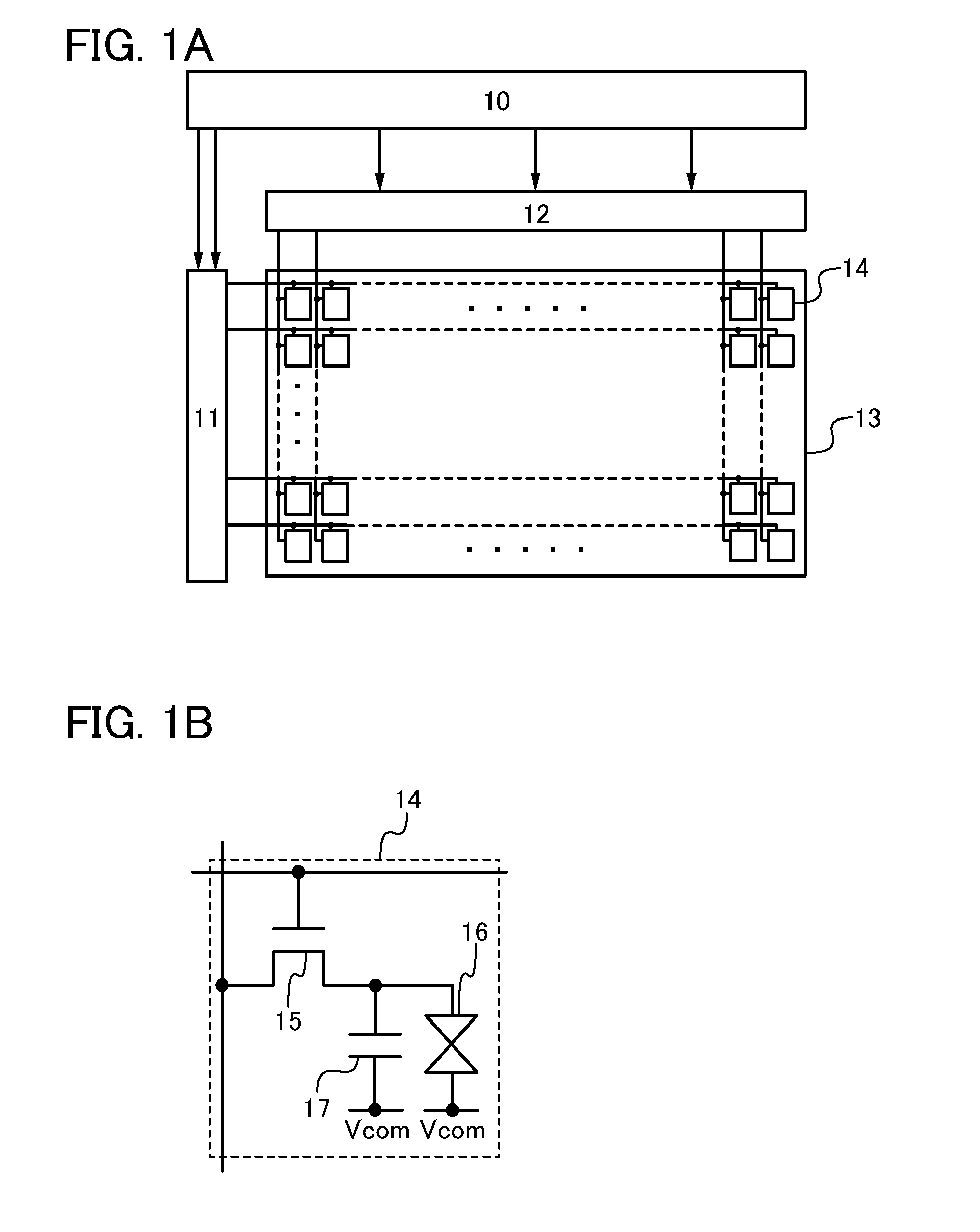Liquid crystal display device and electronic device
a liquid crystal display device and electronic device technology, applied in static indicating devices, instruments, non-linear optics, etc., can solve the problems of increasing increasing the operation temperature, and difficult for liquid crystal display devices, so as to reduce the amount of leakage of image signals through transistors, suppress display degradation (reduction of display quality), and reduce power consumption of liquid crystal display devices
- Summary
- Abstract
- Description
- Claims
- Application Information
AI Technical Summary
Benefits of technology
Problems solved by technology
Method used
Image
Examples
embodiment 1
[0027]In this embodiment, an example of an active matrix liquid crystal display device is described. Specifically, an active matrix liquid crystal display device which can select input of an image signal to a pixel portion is described with reference to FIGS. 1A and 1B, FIG. 2, and FIGS. 3A to 3C.
[0028]A structure example of a liquid crystal display device of this embodiment is described below with reference to FIGS. 1A and 1B. FIGS. 1A and 1B illustrate a structure example of a liquid crystal display device. The liquid crystal display device illustrated in FIG. 1A includes a control circuit 10, a scan line driver circuit 11, a signal line driver circuit 12, and a pixel portion 13. The pixel portion 13 includes a plurality of pixels 14 arranged in a matrix form. FIG. 1B illustrates a structure example of one of the pixels 14. The pixel 14 illustrated in FIG. 1B includes a transistor 15 having a gate terminal electrically connected to the scan line driver circuit 11, and a first term...
embodiment 2
[0057]In this embodiment, an example of the transistor in Embodiment 1 is described with reference to FIGS. 4A to 4D.
[0058]FIGS. 4A to 4D illustrate examples of a specific structure and a process for manufacturing the transistor in Embodiment 1. Note that a thin film transistor 410 illustrated in FIGS. 4A to 4D has a bottom-gate structure called a channel-etched type and is also referred to as an inverted-staggered thin film transistor. Although a single-gate thin film transistor is illustrated in FIGS. 4A to 4D, a multi-gate thin film transistor including a plurality of channel formation regions can be formed as needed.
[0059]A process for manufacturing the thin film transistor 410 over a substrate 400 is described below with reference to FIGS. 4A to 4D.
[0060]First, a conductive film is formed over the substrate 400 having an insulating surface, and then, a gate electrode layer 411 is formed through a first photolithography step. Note that a resist mask used in the step may be forme...
embodiment 3
[0114]In this embodiment, a structure of the liquid crystal display device described in Embodiment 1 which has a touch-panel function is described with reference to FIGS. 5A and 5B.
[0115]FIG. 5A is a schematic view of a liquid crystal display device of this embodiment. FIG. 5A illustrates a structure in which a touch panel unit 502 is stacked on a liquid crystal display panel 501 which is the liquid crystal display device of Embodiment 1 and they are attached with a housing 503. As the touch panel unit 502, a resistive touch sensor, a surface capacitive touch sensor, a projected capacitive touch sensor, or the like can be used as appropriate.
[0116]The liquid crystal display panel 501 and the touch panel unit 502 are manufactured separately and stacked as illustrated in FIG. 5A, whereby the cost of manufacturing a liquid crystal display device having a touch-panel function can be reduced.
[0117]FIG. 5B illustrates a structure of a liquid crystal display device having a touch-panel fun...
PUM
 Login to View More
Login to View More Abstract
Description
Claims
Application Information
 Login to View More
Login to View More - R&D
- Intellectual Property
- Life Sciences
- Materials
- Tech Scout
- Unparalleled Data Quality
- Higher Quality Content
- 60% Fewer Hallucinations
Browse by: Latest US Patents, China's latest patents, Technical Efficacy Thesaurus, Application Domain, Technology Topic, Popular Technical Reports.
© 2025 PatSnap. All rights reserved.Legal|Privacy policy|Modern Slavery Act Transparency Statement|Sitemap|About US| Contact US: help@patsnap.com



